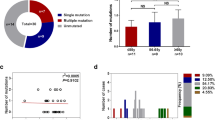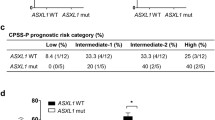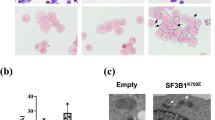Abstract
Acquired pure red cell aplasia (PRCA) is anemia associated with the absence of erythroblasts and is characterized by persistent and easy recurrence. However, the underlying mechanisms of acquired PRCA remain obscure, and the role of gene mutations in the pathogenesis of acquired PRCA is not fully characterized. In the present study, we detected thirty newly diagnosed patients with acquired PRCA using whole exome sequencing, and a potential role for STK10 in acquired PRCA was uncovered. The mRNA levels of STK10 in three patients with STK10 mutations were decreased. These three patients had a poor response to immunosuppressive therapy and two died in the follow-up period. Here we report that knockdown of STK10 inhibits erythroid differentiation and promotes apoptosis of K562 cells. We show that knockdown of STK10 resulted in inhibition of ribosome biogenesis and reduced ribosome levels in K562 cells. We also show that the p53 signaling pathway is activated by knockdown of STK10. Our results imply that ribosome biogenesis downregulation together with pathological p53 activation prevents normal erythropoiesis. Our study uncovers a new pathophysiological mechanism leading to acquired PRCA driven by STK10 mutations.






Similar content being viewed by others
Data availability
No datasets were generated or analysed during the current study.
References
Djaldetti M, Blay A, Bergman M, Salman H, Bessler H (2003) Pure red cell aplasia–a rare disease with multiple causes. Biomed Pharmacother 57(8):326–332. https://doi.org/10.1016/j.biopha.2003.08.001
Da Costa L, O’Donohue MF, van Dooijeweert B, Albrecht K, Unal S, Ramenghi U, Leblanc T, Dianzani I, Tamary H, Bartels M, Gleizes PE, Wlodarski M, MacInnes AW (2018) Molecular approaches to diagnose Diamond-Blackfan anemia: the EuroDBA experience. Eur J Med Genet 61(11):664–673. https://doi.org/10.1016/j.ejmg.2017.10.017
Ball S (2011) Diamond Blackfan anemia. Hematol Am Soc Hematol Educ Program 2011:487–491. https://doi.org/10.1182/asheducation-2011.1.487
Vlachos A, Ball S, Dahl N, Alter BP, Sheth S, Ramenghi U, Meerpohl J, Karlsson S, Liu JM, Leblanc T, Paley C, Kang EM, Leder EJ, Atsidaftos E, Shimamura A, Bessler M, Glader B, Lipton JM (2008) Diagnosing and treating Diamond Blackfan anaemia: results of an international clinical consensus conference. Br J Haematol 142 (6):859–876. https://doi.org/10.1111/j.1365-2141.2008.07269.x
Sawada K, Hirokawa M, Fujishima N, Teramura M, Bessho M, Dan K, Tsurumi H, Nakao S, Urabe A, Omine M, Ozawa K (2007) Long-term outcome of patients with acquired primary idiopathic pure red cell aplasia receiving cyclosporine A. A nationwide cohort study in Japan for the PRCA Collaborative Study Group. Haematologica 92(8):1021–1028. https://doi.org/10.3324/haematol.11192
Means RT Jr (2016) Pure red cell aplasia. Blood 128(21):2504–2509. https://doi.org/10.1182/blood-2016-05-717140
Henras AK, Plisson-Chastang C, O’Donohue MF, Chakraborty A, Gleizes PE (2015) An overview of pre-ribosomal RNA processing in eukaryotes. Wiley Interdiscip Rev RNA 6(2):225–242. https://doi.org/10.1002/wrna.1269
Robledo S, Idol RA, Crimmins DL, Ladenson JH, Mason PJ, Bessler M (2008) The role of human ribosomal proteins in the maturation of rRNA and ribosome production. RNA 14(9):1918–1929. https://doi.org/10.1261/rna.1132008
Le Goff S, Boussaid I, Floquet C, Raimbault A, Hatin I, Andrieu-Soler C, Salma M, Leduc M, Gautier EF, Guyot B, d’Allard D, Montel-Lehry N, Ducamp S, Houvert A, Guillonneau F, Giraudier S, Cramer-Bordé E, Morlé F, Diaz JJ, Hermine O, Taylor N, Kinet S, Verdier F, Padua RA, Mohandas N, Gleizes PE, Soler E, Mayeux P, Fontenay M (2021) p53 activation during ribosome biogenesis regulates normal erythroid differentiation. Blood 137(1):89–102. https://doi.org/10.1182/blood.2019003439
Draptchinskaia N, Gustavsson P, Andersson B, Pettersson M, Willig TN, Dianzani I, Ball S, Tchernia G, Klar J, Matsson H, Tentler D, Mohandas N, Carlsson B, Dahl N (1999) The gene encoding ribosomal protein S19 is mutated in Diamond-Blackfan anaemia. Nat Genet 21(2):169–175. https://doi.org/10.1038/5951
Gazda HT, Sheen MR, Vlachos A, Choesmel V, O’Donohue MF, Schneider H, Darras N, Hasman C, Sieff CA, Newburger PE, Ball SE, Niewiadomska E, Matysiak M, Zaucha JM, Glader B, Niemeyer C, Meerpohl JJ, Atsidaftos E, Lipton JM, Gleizes PE, Beggs AH (2008) Ribosomal protein L5 and L11 mutations are associated with cleft palate and abnormal thumbs in Diamond-Blackfan anemia patients. Am J Hum Genet 83(6):769–780. https://doi.org/10.1016/j.ajhg.2008.11.004
Ebert BL, Pretz J, Bosco J, Chang CY, Tamayo P, Galili N, Raza A, Root DE, Attar E, Ellis SR, Golub TR (2008) Identification of RPS14 as a 5q- syndrome gene by RNA interference screen. Nature 451(7176):335–339. https://doi.org/10.1038/nature06494
Khajuria RK, Munschauer M, Ulirsch JC, Fiorini C, Ludwig LS, McFarland SK, Abdulhay NJ, Specht H, Keshishian H, Mani DR, Jovanovic M, Ellis SR, Fulco CP, Engreitz JM, Schütz S, Lian J, Gripp KW, Weinberg OK, Pinkus GS, Gehrke L, Regev A, Lander ES, Gazda HT, Lee WY, Panse VG, Carr SA, Sankaran VG (2018) Ribosome levels selectively regulate translation and lineage commitment in human hematopoiesis. Cell 173(1):90–103e119. https://doi.org/10.1016/j.cell.2018.02.036
Liu Y, Niu H, Ren J, Wang Z, Yan L, Xing L, Shao Z, Fu R, Cai Z, Wang H (2023) Single-cell RNA sequencing reveals abnormal transcriptome signature of erythroid progenitors in pure red cell aplasia. Genes Dis 11(1):49–52. https://doi.org/10.1016/j.gendis.2023.03.002
Walter SA, Cutler RE Jr., Martinez R, Gishizky M, Hill RJ (2003) Stk10, a new member of the polo-like kinase kinase family highly expressed in hematopoietic tissue. J Biol Chem 278(20):18221–18228. https://doi.org/10.1074/jbc.M212556200
Trainor CD, Mas C, Archambault P, Di Lello P, Omichinski JG (2009) GATA-1 associates with and inhibits p53. Blood 114(1):165–173. https://doi.org/10.1182/blood-2008-10-180489
Batta K, Florkowska M, Kouskoff V, Lacaud G (2014) Direct reprogramming of murine fibroblasts to hematopoietic progenitor cells. Cell Rep 9(5):1871–1884. https://doi.org/10.1016/j.celrep.2014.11.002
Dutt S, Narla A, Lin K, Mullally A, Abayasekara N, Megerdichian C, Wilson FH, Currie T, Khanna-Gupta A, Berliner N, Kutok JL, Ebert BL (2011) Haploinsufficiency for ribosomal protein genes causes selective activation of p53 in human erythroid progenitor cells. Blood 117(9):2567–2576. https://doi.org/10.1182/blood-2010-07-295238
Dai MS, Lu H (2004) Inhibition of MDM2-mediated p53 ubiquitination and degradation by ribosomal protein L5. J Biol Chem 279(43):44475–44482. https://doi.org/10.1074/jbc.M403722200
Fumagalli S, Di Cara A, Neb-Gulati A, Natt F, Schwemberger S, Hall J, Babcock GF, Bernardi R, Pandolfi PP, Thomas G (2009) Absence of nucleolar disruption after impairment of 40S ribosome biogenesis reveals an rpL11-translation-dependent mechanism of p53 induction. Nat Cell Biol 11(4):501–508. https://doi.org/10.1038/ncb1858
Jaako P, Debnath S, Olsson K, Zhang Y, Flygare J, Lindström MS, Bryder D, Karlsson S (2015) Disruption of the 5S RNP-Mdm2 interaction significantly improves the erythroid defect in a mouse model for Diamond-Blackfan anemia. Leukemia 29(11):2221–2229. https://doi.org/10.1038/leu.2015.128
Kulasekararaj AG, Smith AE, Mian SA, Mohamedali AM, Krishnamurthy P, Lea NC, Gäken J, Pennaneach C, Ireland R, Czepulkowski B, Pomplun S, Marsh JC, Mufti GJ (2013) TP53 mutations in myelodysplastic syndrome are strongly correlated with aberrations of chromosome 5, and correlate with adverse prognosis. Br J Haematol 160(5):660–672. https://doi.org/10.1111/bjh.12203
Li X, Wilson AF, Du W, Pang Q (2018) Cell-cycle-specific function of p53 in Fanconi Anemia hematopoietic stem and progenitor cell proliferation. Stem Cell Rep 10(2):339–346. https://doi.org/10.1016/j.stemcr.2017.12.006
Acknowledgements
We thank all patients who consented to disclose their medical records and answered our review calls. Their cooperation and helpful comments throw light upon our data collection and statistical analysis.
Funding
This study was supported by grants from National Natural Science Foundation of China (81900118), Chinese Academy of Medical Sciences (CAMS) Innovation Fund for Medical Sciences (2016-I2M-3-004), National Key Research and Development Program of China (2016YFC0901500), Clinical Science Foundation of Anhui Medical University (2021XKJ160) and Research Project of Integrated Traditional Chinese and Western Medicine of Tianjin Health Commission (2023078).
Author information
Authors and Affiliations
Contributions
Z.L., J.Y., and B.H. designed the study, Z.L., J.Y., X.S., X.L., X.Q., X.Z., Y.D., H.L. and D.F. performed the experiments and analyzed the data, M.C. collected samples, Z.L. J.Y. and X.S. wrote the manuscript. All authors reviewed the manuscript and approved the final version of the manuscript.
Corresponding authors
Ethics declarations
Ethics approval and consent to participate
This study was approved by the Peking union medical college hospital ethics committee and was performed in accordance with the Declaration of Helsinki. Informed consent was obtained from all patients for being included in the study.
Consent for publication
Not applicable.
Competing interests
The authors declare no competing interests.
Additional information
Publisher’s Note
Springer Nature remains neutral with regard to jurisdictional claims in published maps and institutional affiliations.
Electronic supplementary material
Below is the link to the electronic supplementary material.
Rights and permissions
Springer Nature or its licensor (e.g. a society or other partner) holds exclusive rights to this article under a publishing agreement with the author(s) or other rightsholder(s); author self-archiving of the accepted manuscript version of this article is solely governed by the terms of such publishing agreement and applicable law.
About this article
Cite this article
Yang, J., Shi, X., Liu, X. et al. STK10 mutations block erythropoiesis in acquired pure red cell aplasia via impairing ribosome biogenesis. Ann Hematol (2024). https://doi.org/10.1007/s00277-024-05802-z
Received:
Accepted:
Published:
DOI: https://doi.org/10.1007/s00277-024-05802-z




